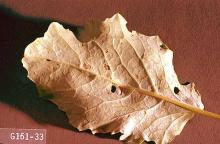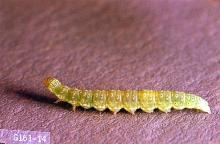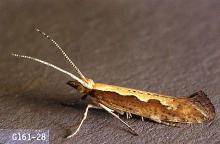Plutella xylostella
Pest description and crop damage Diamondback larvae are smaller than most other caterpillars in cole crops, about 0.31 inch when full grown. The larval body is wider in the middle and tapers at both ends, with two legs (prolegs) on the last segment forming a distinctive V-shape at the rear end. When disturbed, the larvae wiggle frantically or rapidly attach a silken line to a leaf and drop over the edge. They feed mostly on outer or older leaves of older plants, chewing out small holes, or at the growing points of young plants. They also feed on floral stalks and flower buds. Adult moths are small, slender, and grayish brown. Male moths display three diamond-shaped markings on their back. In the Pacific Northwest, the damage from diamondback moth is not so much from feeding as from contamination by pupae. Late stage instars crawl into stems infesting harvested crops.
Biology and life history Cabbage is the preferred host, but it also attacks all cole family crops. The adult overwinters in trash in and around fields. Adults emerge in May and early June and lay eggs singly or in twos or threes mainly on the upper sides of leaves. The eggs are minute. They hatch in 4 to 8 days. Larvae feed mostly on the undersides of outer or older leaves of older plants, chewing out small holes, and mature in 10 to 30 days. They then spin loose white cocoons, which they attach to leaves or stems, and pupate within them. Adults emerge in 10 to 14 days. There may be two to four overlapping generations each year.
Pest monitoring Natural enemies and insecticides applied to control other pests keep the diamondback moth under satisfactory control in most fields, but keep records of diamondback moths as you monitor for other caterpillars. Adult moths frequently migrate from fields being harvested or disked under.
Management-biological control
Natural enemies, including an ichneumid wasp and the egg parasite Trichogramma pretiosum, often effectively control diamondback moth in California. Therefore, take into account the level of parasitism when making control decisions. Clearly, Bt is much easier on the beneficial insects, and its use, when needed, helps conserve the beneficial insect complex.
Management-chemical control: HOME USE
- acetamiprid
- azadirachtin (neem oil)-Some formulations are OMRI-listed for organic use.
- Bacillus thuringiensis var. kurstaki (Btk)-Some formulations are OMRI-listed for organic use.
- bifenthrin (as a mix with zeta-cypermethrin).
- carbaryl
- cyfluthrin
- lambda-cyhalothrin
- malathion
- permethrin
- plant-derived essential oils (rosemary, peppermint etc.)-These have some efficacy against lepidopteran larvae. Some formulations are OMRI-listed for organic use.
- pyrethrins-Some formulations are OMRI-listed for organic use.
- spinosad-Some formulations are OMRI-listed for organic use.
- zeta-cypermethrin
Management-chemical control: COMMERCIAL USE
- alpha-cypermethrin (Fastac EC) at 0.014 to 0.025 lb ai/A. PHI 1 day. REI 12 hr. Retreatment interval 7 days. Do not exceed 0.075 lb ai/A per season.
- azadirachtin (Neemix 4.5) at 0.18 to 0.25 lb ai/A. PHI 0 days. REI 4 hr. OMRI-listed for organic use.
- Bacillus thuringiensis (Javelin) at 0.12 to 1.5 lb/A. PHI 0 days. REI 4 hr. Acts slowly; may need multiple applications. Add an appropriate spreader-sticker to enhance control. Most effective on small larvae. Some formulations are OMRI-listed for organic use.
- beta-cyfluthrin (Baythroid XL) at 0.019 to 0.025 lb ai/A. PHI 0 days. REI 12 hr. Retreatment interval 7 days. Do not exceed 0.1 lb ai/A per season. Larvae only.
- bifenthrin (Brigade 2EC) at 0.033 to 0.1 lb ai/A. PHI 7 days. REI 12 hr. Retreatment interval 7 days. Do not exceed 0.4 lb ai/A per season.
- bifenthrin/imidacloprid (Brigadier) at 0.06 to 0.095 lb ai/A. PHI 7 days. REI 12 hr. Retreatment interval 7 days. Limit 5 treatments after bloom. Do not exceed 0.24 lb ai/A imidacloprid and 0.5 lb ai/A bifenthrin.
- bifenthrin/zeta-cypermethrin (Hero EW) at 0.04 to 0.1 lb ai/A. PHI 7 days. REI 12 hr. Retreatment interval 7 days. Do not exceed 0.45 lb ai/A per season.
- Burkholderia spp. (Venerate XC) at 1 to 4 quarts/A product. PHI 0 days. REI 4 hr. OMRI-listed for organic use.
- carbaryl (Sevin 4F) at 1 to 2 lb ai/A. PHI 14 days. REI 12 hr. Retreatment interval 7 days. Limit 4 treatments. Do not exceed 6 lb ai/A per season.
- chlorantraniliprole (Coragen) at 0.045 to 0.098 lb ai/A at plant, drip or foliar. PHI 3 days. REI 4 hr. Limit 4 treatments per year. Retreatment interval 3 days foliar, 10 days drip. Do not exceed 0.2 lb ai/A per season. Consult label for application details.
- chlorantraniliprole/thiamethoxam (Voliam Flexi) at 0.1 to 0.172 lb ai/A. PHI 7 days. REI 12 hr. Retreatment interval 7 days. Do not exceed 0.172 lb ai of thiamethoxam or 0.2 lb ai of chlorantraniliprole per acre per growing season.
- Chromobacterium subtsugae (Grandevo) at 0.3 to 0.9 lb ai/A per 100 gal. PHI 0 days. REI 4 hr. OMRI-listed for organic use.
- cyantraniliprole (Exirel) at 0.045 to 0.088 lb ai/A. PHI 1 day. REI 12 hr. Retreatment interval 5 days. Do not exceed 0.4 lb ai/A per year.
- cyclaniliprole (Harvanta 50SL) at 0.036 to 0.054 lb ai/A. PHI 1 day. REI 12 hr. Retreatment interval 5 days. Limit 3 treatments. Do not exceed 0.22 lb ai/A per year.
- cyfluthrin (Tombstone) at 0.038 to 0.05 lb ai/A. PHI 0 days. REI 12 hr. Do not exceed 0.2 lb ai/A per season. Retreatment interval 7 days.
- emamectin benzoate (Proclaim) at 0.0075 to 0.015 lb ai/A. PHI 14 days. REI 12 hr. Retreatment interval 7 days. Do not exceed 0.09 lb ai/A per season. Do not graze.
- indoxacarb (Avaunt) at 0.065 lb ai/A. PHI 3 days. REI 12 hr. Retreatment interval 3 days. Do not exceed 0.26 lb ai/A per season.
- methomyl (Lannate SP) at 0.45 to 0.9 lb ai/A. PHI 10 days. REI 48 hr. Do not exceed 3.6 lb ai/A per season. Limit 8 treatments.
- spinetoram (Radiant SC) at 0.039 to 0.078 lb ai/A. PHI 1 day. REI 4 hr. Retreatment interval 4 days. Do not exceed 0.266 lb ai/A per season. Limit 6 treatments per season.
- spinosad (Success, Entrust SC) at 0.023 to 0.0625 lb ai/A. PHI 1 day. REI 4 hr. Do not exceed 0.45 lb ai/A per crop. Limit 6 treatments per season. Entrust SC is OMRI-listed for organic use.
- thiamethoxam/chlorantraniliprole (Durivo) at 0.194 to 0.257 lb ai/A applied to the soil. PHI 30 days. REI 12 hr. Do not exceed 0.172 lb ai of thiamethoxam or 0.2 lb ai of chlorantraniliprole per acre per growing season.
- tolfenpyrad (Torac) at 0.17 to 0.21 lb ai/A. PHI 1 day. REI 12 hr. Retreatment interval 14 days. Limit 4 treatments per year. Do not exceed 0.42 lb ai/A per year.
- zeta-cypermethrin (Mustang) at 0.028 to 0.05 lb ai/A. PHI 1 day. REI 12 hr. Retreatment interval 7 days. Do not exceed 0.3 lb ai/A per season.




